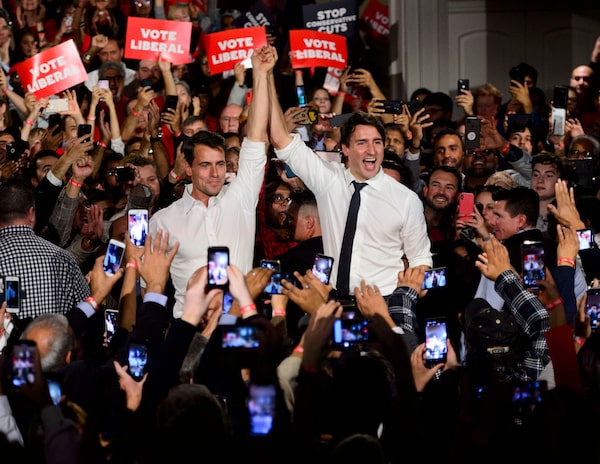
The Liberals snatched away the Milton seat held by the Conservatives’ smart and likeable deputy leader, Lisa Raitt. The seat went to star candidate Adam van Koeverden, the Olympic paddler.Sean Kilpatrick/The Canadian Press
Many Canadians resent Toronto for its outsized economic, financial and cultural power. Now they have another reason to feel put out. Toronto and the dynamic communities in its orbit have become the key to winning elections in this country. Politicians from every party flocked there during this campaign, as they have for several election cycles. Every mall and fairground from Markham to Oakville was overrun by glad-handing politicians.
The results on Monday night confirmed the region’s central role in determining federal winners. The Liberals held on to power, despite a record-low share of the popular vote, because they held on to most of their Ontario seats, and they held on to Ontario largely because they held on to Greater Toronto.
The Liberals took all of Toronto proper, painting it solid red. They also took the two populous cities on its western flank: Mississauga and Brampton. Andrew Scheer’s Conservatives won only a handful of seats in the region, isolated patches of blue in a red sea. The Liberals even snatched away the Milton seat held by the Conservatives’ smart and likeable deputy leader, Lisa Raitt. It went to star candidate Adam van Koeverden, the Olympic paddler.
All of this is bound to make the rest of Canada feel doubly bitter about the place Toronto occupies in its national life. Well, the rest of Canada had better get used to it.
The explosive growth of the Toronto region means that its political influence can only rise. The numbers are staggering. When the Toronto Transit Commission issued a report this month on the Ontario government’s latest mass transit plan, it said almost offhandedly that “over the next twenty years, the city’s population is projected to grow by about 960,000 people. By 2041, the city’s population will be more than 3,900,000, exceeding the provincial growth plan forecasts by more than 500,000.”
Toronto is already the fourth most populous city in North America. It took that spot from Chicago in 2013. Researchers from Ryerson University reported this year that the central city was also the fastest growing in the United States and Canada, far exceeding even the booming cities of the U.S. Southwest. The thickets of construction cranes on its ever-changing skyline testify to the transformation.
The growth in the satellite communities beyond the central city and its inner suburbs is even more astonishing. Mississauga already claims to be Canada’s sixth largest city, Brampton its ninth. Milton, where Mr. Van Koeverden won, grew by 30 per cent in the last census period. Ontario’s Ministry of Finance reports that Greater Toronto’s population will increase by 3.4 million by 2046, reaching more than 10 million.
More people means more seats, as electoral officials add and adjust ridings to reflect the latest numbers. The 905, the ring of cities and suburbs in the area code outside of central Toronto, already has 30 seats, more than Manitoba and Saskatchewan put together.
So Toronto’s electoral sway is a fact of life, as it should be. In our system of representation by population, more people is supposed to mean more clout. Precisely because it is so central, Toronto has often been taken for granted by Ottawa.
That is changing now. Thanks to its political importance, the city is getting more aid from Ottawa with the considerable challenges it faces. Its explosive growth is putting strains on the city and its residents. Its transit system is stressed and underbuilt. Its housing is expensive. Its poorer communities, especially in its inner suburbs, are struggling. The federal parties are finally stepping up with offers of help. The Liberal Party, for one, has promised billions for transit and housing.
It makes sense to lavish attention on a city – a megalopolis, really – that is so critical to the country’s economic success. Canada is more and more an urban country. Whether Canada succeeds depends on whether its biggest city succeeds. New patterns of living and working will evolve here.
Whether Canada succeeds also depends on how well it absorbs the throngs of new immigrants that are arriving in its big metropolitan areas. Toronto is the main testing ground. The inflow of people from every corner of the globe is changing the city, as it is changing the country. These new Canadians need to feel they have a say in the progress of the country they have chosen.
Largely because of immigration, Toronto’s population is younger than Ontario’s as a whole. The region has more children and more growing families. The future is here, in all those supermarkets, apartment blocks, schoolyards and subdivisions on Toronto’s edges.
Toronto deserves every bit of its growing influence. Sensible Canadians will cheer it on.
Our Morning Update and Evening Update newsletters are written by Globe editors, giving you a concise summary of the day’s most important headlines. Sign up today.
 Marcus Gee
Marcus Gee